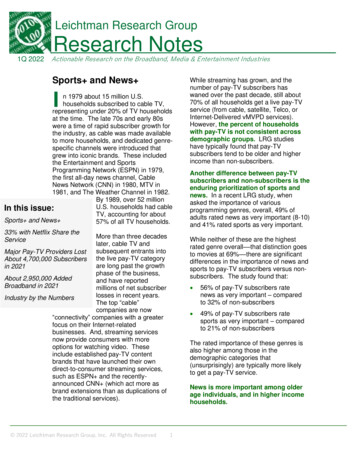
Transcription
Leichtman Research GroupResearch Notes1Q 2022Actionable Research on the Broadband, Media & Entertainment IndustriesSports and News In 1979 about 15 million U.S.households subscribed to cable TV,representing under 20% of TV householdsat the time. The late 70s and early 80swere a time of rapid subscriber growth forthe industry, as cable was made availableto more households, and dedicated genrespecific channels were introduced thatgrew into iconic brands. These includedthe Entertainment and SportsProgramming Network (ESPN) in 1979,the first all-day news channel, CableNews Network (CNN) in 1980, MTV in1981, and The Weather Channel in 1982.By 1989, over 52 millionU.S. households had cableIn this issue:TV, accounting for aboutSports and News 57% of all TV households.33% with Netflix Share theServiceMore than three decadeslater, cable TV andsubsequent entrants intoMajor Pay-TV Providers LostAbout 4,700,000 Subscribers the live pay-TV categoryare long past the growthin 2021phase of the business,About 2,950,000 Addedand have reportedBroadband in 2021millions of net subscriberlosses in recent years.Industry by the NumbersThe top “cable”companies are now“connectivity” companies with a greaterfocus on their Internet-relatedbusinesses. And, streaming servicesnow provide consumers with moreoptions for watching video. Theseinclude established pay-TV contentbrands that have launched their owndirect-to-consumer streaming services,such as ESPN and the recentlyannounced CNN (which act more asbrand extensions than as duplications ofthe traditional services). 2022 Leichtman Research Group, Inc. All Rights ReservedWhile streaming has grown, and thenumber of pay-TV subscribers haswaned over the past decade, still about70% of all households get a live pay-TVservice (from cable, satellite, Telco, orInternet-Delivered vMVPD services).However, the percent of householdswith pay-TV is not consistent acrossdemographic groups. LRG studieshave typically found that pay-TVsubscribers tend to be older and higherincome than non-subscribers.Another difference between pay-TVsubscribers and non-subscribers is theenduring prioritization of sports andnews. In a recent LRG study, whenasked the importance of variousprogramming genres, overall, 49% ofadults rated news as very important (8-10)and 41% rated sports as very important.While neither of these are the highestrated genre overall––that distinction goesto movies at 69%––there are significantdifferences in the importance of news andsports to pay-TV subscribers versus nonsubscribers. The study found that: 56% of pay-TV subscribers ratenews as very important – comparedto 32% of non-subscribers 49% of pay-TV subscribers ratesports as very important – comparedto 21% of non-subscribersThe rated importance of these genres isalso higher among those in thedemographic categories that(unsurprisingly) are typically more likelyto get a pay-TV service.News is more important among olderage individuals, and in higher incomehouseholds.1
66% of ages 55 rate news as veryimportant – compared to 48% ofages 35-54, and 32% of ages 18-3433% with Netflix Share theService 57% with annual household incomes 75,000 rate news as veryimportant – compared to 45% withhousehold incomes 75,000New consumer research fromLeichtman Research Group foundthat 83% of U.S. households have atleast one streaming video service fromfifteen top direct-to-consumer (DTC) andsubscription video on-Demand (SVOD)services; including 67% of all householdswith Netflix.Sports is more important in higherincome households, as well as amongmen. 52% with household incomes 75,000 rate sports as veryimportant – compared to 39% withhousehold incomes of 30,000 75,000, and 27% with householdincomes 30,000However, not all Netflix and other DTCservices are paid for directly by thosewho use them.The study found that:49% of men rate sports as veryimportant – compared to 34% ofwomenSports and news were important parts ofgrowing the pay-TV business, andremain disproportionately popular amongcurrent pay-TV subscribers. 64% with Netflix fully pay for theservice and do not share it with othersoutside the household 33% of Netflix services are used inmore than one household:o 15% of Netflix services are usedand paid for by those that alsoshare them with someone outsidethe householdo 15% of Netflix services are used inone household but are borrowedfrom another household that ispaying for the serviceo 3% of services are used bymultiple households that sharecosts 3% of Netflix services are not paid forbecause they come with another serviceGoing forward, these genres will continueto play important roles in balancing thelegacy model with direct-to-consumerofferings. It is important to keep in mindthat these options are not mutuallyexclusive. Consumers will continue toget the services and content that bestserve their households’ needs andbudgets.These findings are based on an onlinesurvey of 4,400 households from throughoutthe United States and are part of a newLRG study, Internet-Delivered Pay-TVServices 2022. This is LRG’s fifth annualstudy focused on the vMVPD category,along with other DTC streaming videoservices.The mean number of DTC/SVODservices per household is 3.6 –compared to 2.9 in 2021, and 2.4in 2020Other findings from the study include: 2022 Leichtman Research Group, Inc. All Rights Reserved2
29% of all DTC services are sharedwith others outside the household 12% of all DTC services are fully paidfor by someone outside the household 34% of adults ages 18-34 have atleast one DTC service that is fully paidfor by someone else – compared to14% of ages 35 Adults ages 18-44 account for 65% ofall with a vMVPD pay-TV service 79% of vMVPD subscribers are verysatisfied with their service – comparedto 76% in 2020, and 69% in 2018 23% of all vMVPD services are sharedby multiple households, including 7%of all vMVPD services that are fullypaid for by someone outside thehouseholdPassword sharing is an inherent featureof most streaming services. Sharinghelps to expand the user base and retaincustomers, but it also creates a gapbetween the number of households thathave a service and actual payingsubscribers.Leichtman Research Group foundthat the largest pay-TV providersin the U.S. – representing about 93% ofthe market – lost about 4,690,000 netvideo subscribers in 2021, compared toa pro forma net loss of about 4,870,000in 2020.The top pay-TV providers now account forabout 76.1 million subscribers – with thetop seven cable companies having 41.3million video subscribers, other traditionalpay-TV services having over 26.8 millionsubscribers, and the top publicly reportingInternet-delivered (vMVPD) pay-TVservices having 7.9 million subscribers.Key findings for the year include:For example, about two-thirds of U.S.households report having Netflix, but thisincludes about 10% of U.S. householdsthat don’t pay for the service because it isborrowed from someone else’ssubscription.5% of all households had Netflix inthe past year, but currently do not– similar to 6% for Hulu, 5% forAmazon Prime, and 5% for livepay-TV services 2022 Leichtman Research Group, Inc. All Rights ReservedMajor Pay-TV ProvidersLost About 4,700,000Subscribers in 2021 Top cable providers had a net loss ofabout 2,695,000 video subscribers in2021 – compared to a loss of about1,940,000 subscribers in 2020 Other traditional pay-TV services hada net loss of about 2,890,000subscribers in 2021 – compared to aloss of about 3,845,000 in 2020 Top publicly reporting vMVPDs addedabout 895,000 subs in 2021 – comparedto a gain of about 915,000 in 2020 Traditional pay-TV services (notincluding vMVPD) had a net loss ofabout 5,585,000 subscribers in 2021 –compared to a net loss of about5,785,000 in 2020While the pay-TV industry continued tolose subscribers, net losses in 2021 werefairly similar to those in recent years. In2021, the top pay-TV providers had a netloss of about 4.7 million subscribers,compared to a pro forma loss of about 4.9million subscribers in 2020, and 4.1 millionin 2019.3
About 2,950,000 AddedBroadband in 2021Leichtman Research Group foundthat the largest cable and wirelinephone providers in the U.S. –representing about 96% of the market –acquired about 2,950,000 net additionalbroadband Internet subscribers in 2021,compared to a pro forma gain of about4,860,000 subscribers in 2020, and about2,550,000 in 2019.These top broadband providers nowaccount for about 108.4 millionsubscribers, with top cable companieshaving about 75.7 million broadbandsubscribers, and top wireline phonecompanies having about 32.7 millionsubscribers.Findings for the year include: Overall, broadband additions in 2021were 61% of the total in 2020, and115% of the total in 2019 The top cable companies had about2.8 million net adds in 2021, 58% ofthe cable broadband additions in2020, and 89% of additions in 2019 The top wireline phone companiesadded about 150,000 subscribers in2021 – compared to a gain of about30,000 subscribers in 2020, and anet loss of about 590,000subscribers in 2019o Telcos had about 1.8 million netadds via fiber in 2021 – comparedto about 1.64 million fiber net addsin 2020Broadband additions proved to be resilientin 2021 following 2020’s pandemic-relatedsurge in subscribers. The top broadbandproviders added significantly fewersubscribers in 2021 than in 2020, but thenet adds in 2021 were higher than in eachyear from 2016-2019. 2022 Leichtman Research Group, Inc. All Rights Reserved4Fixed wireless/5G home Internetservices from T-Mobile andVerizon had 874,000 subscribersat the end of 2021 – including719,000 net adds in 2021
Industry by the NumbersTop Pay-TV Providers in the U.S.Cable CompaniesSubscribers at end of 4Q 2021Net Adds in 0,900)Mediacom572,000(71,000)Breezeline/Atlantic Broadband **346,729(36,271)Cable One**261,000(50,000)41,311,029(2,695,171)DIRECTV 14,600,000(1,905,000)DISH TV (DBS)8,221,000(595,000)Verizon Fios 0(2,888,000)Hulu Live TV4,300,000300,000Sling TV2,486,00012,000fuboTV1,129,807581,927Total Top vMVPD 7,915,807893,927Total Top Pay-TV76,071,836(4,689,244)Total Top CableOther Traditional ServiceFrontier (Telco)*Total Top Other TraditionalInternet-Delivered (vMVPD)Sources: The Companies and Leichtman Research Group, Inc.*LRG estimate** Includes LRG estimate of pro forma net adds LRG estimate. Formerly AT&T Premium TV, includes DIRECTV, U-verse, and DIRECTV Stream (formerly AT&T TV). vMVPD does not include YouTube TV or Philo, as neither regularly report resultsCompany subscriber counts may not solely represent residential householdsTop pay-TV providers represent approximately 93% of all subscribersNet additions reflect pro forma results from system sales and acquisitions, and reporting adjustments -- therefore, comparing totalsin this quarter’s Notes to prior Notes may not produce accurate findings 2022 Leichtman Research Group, Inc. All Rights Reserved5
Top Broadband Internet Providers in the U.S.Cable CompaniesSubscribers at end of 4Q 2021Net Adds in Mediacom1,463,00025,000Cable One**1,055,00063,000Breezeline/Atlantic Broadband**716,77818,778WOW 15,504,000120,000Verizon 0TDS526,00032,700Cincinnati Bell*440,0003,900Consolidated384,564(16,793)Total Top Telco32,702,064148,007Total Top Broadband108,354,7422,951,285Total Top CableWireline Phone CompaniesSources: The Companies and Leichtman Research Group, Inc.*LRG estimate** Includes LRG estimate of pro forma net adds Does not include 173,000 fixed wireless net adds in 2021, bringing the total to about 228,000 subscribersDoes not include T-Mobile’s 546,000 fixed wireless net adds in 2021, bringing the total to 646,000 subscribersTDS includes about 309,000 wireline subscribers and about 217,000 cable subscribersCompany subscriber counts may not solely represent residential households – about 6% of the total are non-residentialTop cable and telephone companies represent approximately 96% of all subscribersNet additions reflect pro forma results from system sales and acquisitions, and reporting adjustments – therefore, comparing totalsin this quarter’s Notes to prior Notes may not produce accurate finding 2022 Leichtman Research Group, Inc. All Rights Reserved6
Leichtman Research Group, Inc.www.LeichtmanResearch.com(603) 397-5400 2022 Leichtman Research Group, Inc. All Rights Reserved7
the market - lost about 4,690,000 net video subscribers in 2021, compared to a pro forma net loss of about 4,870,000 in 2020. The top pay-TV providers now account for about 76.1 million subscribers -with the top seven cable companies having 41.3 million video subscribers, other traditional pay-TV services having over 26.8 million










